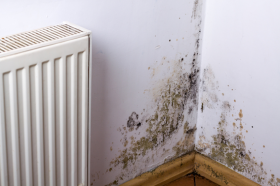
Damp is one of the most common property issues found across the UK, with an estimated one in five households experience issues with damp in their lifetime. “Damp essentially means there is a presence of moisture within the property,” building and construction expert Thomas Goodman from MyJobQuote explains. “Damp occurs easily but can be difficult to identify and treat yourself, especially if it’s left to worsen over time.”
Below, Goodman presents the five most common causes of damp and offers advice on how to treat and prevent damp from occurring in the home.
Excessive moisture
“Excessive moisture in a property is one of the main causes of damp, as it can be caused by everyday activities,” Goodman explains. “Examples of common causes include steam when cooking or boiling a kettle, having hot showers or baths, and drying wet clothes indoors.” As these are such everyday tasks, this means it can be difficult to avoid allowing excess moisture into your home, however Goodman advises there are still ways to allow such excess moisture to escape.
“Allow for extra ventilation in rooms prone to experiencing more moisture, for example the kitchen and bathroom. When showering, make sure you have an extractor fan fitted to help remove excess moisture. If you don’t have an extractor fan, or find it doesn’t work efficiently, installing one with a professional electrician can be done quickly and costs an average of £300 for the day’s work.” In addition to an extractor fan, leaving the bathroom window open allows steam to escape and helps dry out the room.
Poor ventilation
Poor ventilation is not only one of the main causes of damp, but can also lead to health issues, as there is a lack of fresh air in a poorly ventilated home. “The best and easiest tip to help ventilate your home is to leave windows open as this will allow fresh air to circulate your home,” Goodman advises. “For a longer term solution, consider installing air bricks into the exterior of your home.” allow better airflow and will prevent excess moisture leading to damp over time.”
Goodman explains: “Air bricks are bricks with lots of small holes which allow better airflow and prevents excess moisture leading to damp over time. Having a labourer fit them outside typically only takes a day or so, depending on how many bricks are deemed necessary.”
Insufficient heating
Generally speaking, central heating can help reduce condensation in your home, resulting in less chance of damp issues arising. “By turning on central heating, it is thought that the heat in the air helps dry out the excess moisture in the airflow,” Goodman explains. “However, it is worth noting that turning on the central heating can have the opposite effect and result in causing more issues with damp.”
Goodman continues, “Especially when a home isn’t properly ventilated, turning on the central heating can lead to air becoming trapped and moist. This air will then settle onto colder surfaces, and this is what causes damp problems. If your home is prone to cold spots, for example you notice certain areas in your room don’t get as warm, or if there are cold spots present on your radiator, then this could be a sign your central heating isn’t up to scratch which can cause problems.”
If there are cold spots present in your radiator then this a sign to bleed your radiator, as it means there is air trapped which means the heat inside can’t circulate properly.
Structural building faults
Structural damp means moisture is present in the structure of a building. It is common yet can be quite difficult to identify and work out the cause. “When a building has structural damp, the damp can have adverse effects on the inside of your home,” Goodman explains. “To identify the problem, you may notice ‘symptoms’ such as plaster and paint flaking off, external brick and mortar crumbling and even a growth of mould and fungi, which can be particularly alarming as it can eventually lead to health issues.”
Structural damp can be caused by a number of faults, from simple water leaks to more serious rising damp, which is caused by ground water moving up and rising into the property. Treatment for this takes more time than ventilation issues and will require an expert to determine the specific cause. “If the issue is rising damp, then the most common solution is to damp-proof course the building, which requires injecting a damp-proof cream or installing a waterproof course into the wall.
Leaks
There are a number of reasons why leaks can occur and subsequently penetrate walls. From a leaking pipe to an overflowing gutter outside, leaks cause excess water to get into the property and cause serious damp issues, typically referred to as penetrating damp.
“If pipes or gutters are blocked or cracked then this can disrupt the flow of water and cause water to penetrate the building,” Goodman explains. “If you can easily identify the cause of a blockage, for example if you notice your gutters are full of leaves and debris then fixing this should be simple to resolve the issue and you should be able to notice the difference. However, if your leak is coming from internal walls then this may require invasive building work to find the source and replace the pipes. Hiring a trusted professional is the best thing to do here, as they will have expertise in finding the source and fixing the problem.”